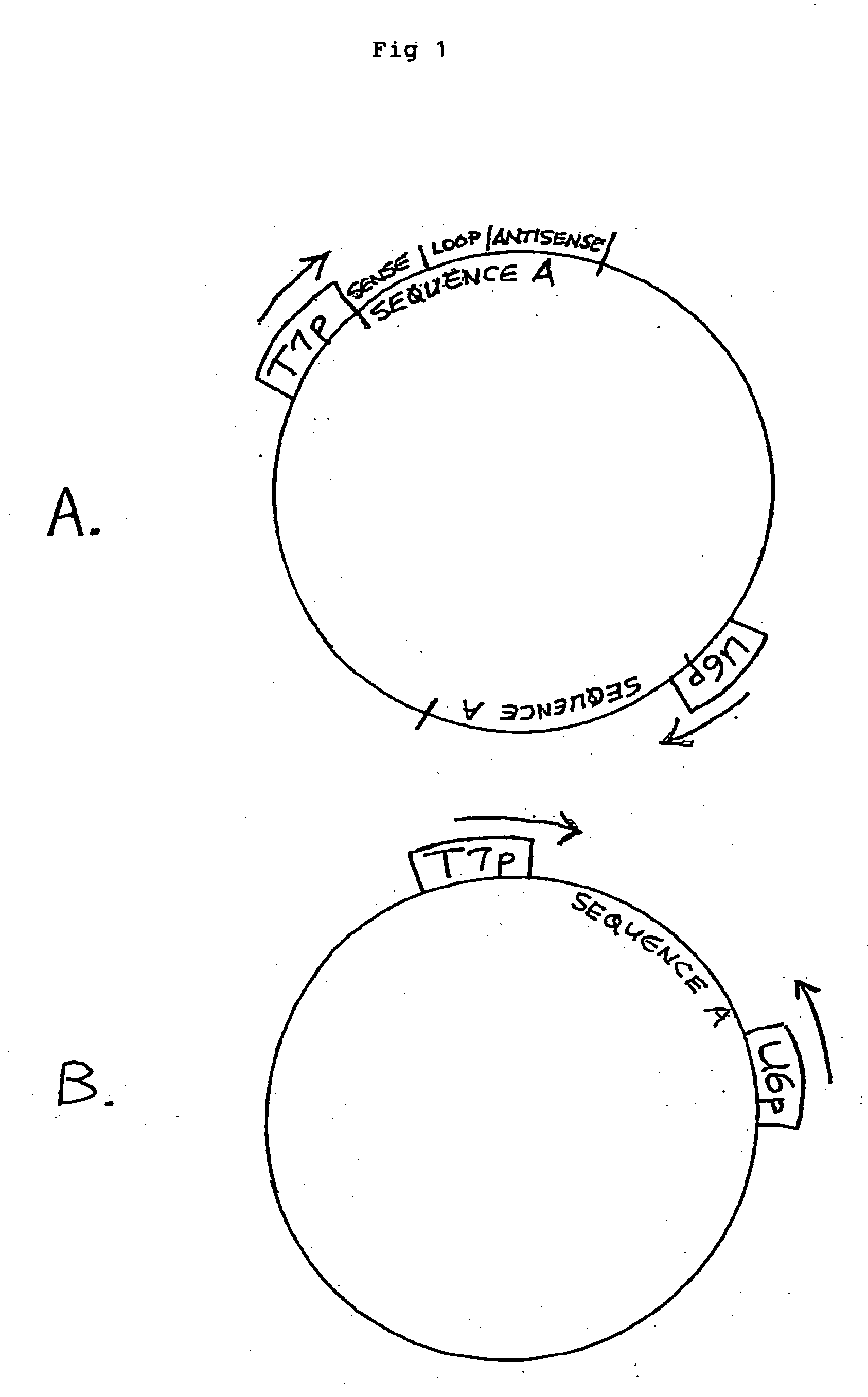Multiple-compartment eukaryotic expression systems
- Summary
- Abstract
- Description
- Claims
- Application Information
AI Technical Summary
Benefits of technology
Problems solved by technology
Method used
Image
Examples
example 1
A Plasmid Multi-Compartment Eukaryotic Expression System Encoding Two Copies Each of Two Different HBV-Derived Hairpin dsRNAs, Each Located within a Separate Cistron.
[0178] A plasmid is constructed which encodes two copies each of two different HBV-specific hairpin RNAs (an RNA strand capable of assuming a double stranded structure by virtue of comprising inverted sense and antisense sequences separated by a “loop” sequence). Each such sequence, Sequence A and Sequence B, is under the control of two separate and distinct promoters, each transcriptionally active in a different subcellular compartment of a eukaryotic cell: the bacteriophage T7 promoter (T7p) (which promotes transcription by T7 RNA polymerase in the cytoplasm) and the human U6 promoter (an RNA pol III promoter transcriptionally active in the nucleolus). The transcription units (cistrons) are arranged such that there is a separate location for each cistron (FIG. 7) for a total of four cistrons. The T7 promoter can be ...
example 2
A Vector Encoding an HBV-Derived Hairpin RNA, in the Flanked Promoter Arrangement.
[0187] A plasmid is constructed which encodes an HBV-specific hairpin RNA (Sequence A from Example 1), under the control of two separate, different compartment promoters: the bacteriophage T7 promoter (cytoplasmic, when T7 RNA polymerase is also supplied) and the human U6 promoter (RNA pol III, nucleolar). The sequence is transcribed in one direction by the T7 promoter and in the reverse direction by the U6 promoter. A T7 terminator is cloned at the 3′ end of Sequence A, relative to the T7 promoter, and a U6 terminator is cloned at the 3′ end of Sequence A, relative to the U6 promoter. The T7 transcript will contain from 5′ to 3′: the reverse complement to the U6 terminator and the Sequence A hairpin (e.g., sense-loop-antisense). The U6 transcript will contain from 5′ to 3′: the reverse complement to the T7 terminator, and the Sequence A hairpin (e.g., antisense-loop-sense) Although the HBV-hairpin s...
example 3
A Multi-Compartment Eukaryotic Expression Vector Encoding Two HBV Hairpin RNAs Shows Efficacy In Vivo.
[0196] The experiment described below utilizes hydrodynamic delivery as a method to co-deliver replication competent HBVayw plasmid together with the multi-compartment eukaryotic expression vector described in Example 1, and shown in FIG. 7, which encodes two HBV hairpin RNA molecules, each from two different cistrons with subcompartment-distinct promoters, and the T7 RNA polymerase expression plasmid of Example 1. Hydrodynamic delivery is ideal for this experiment because it results in efficient delivery of nucleic acid to the liver [8]. Combination of the dsRNA effector plasmid and replication competent HBV plasmid into the same formulation increases the likelihood that all plasmids are taken up by the same cells. Because expressed effector dsRNA are present in the majority of cells bearing the replicating HBV plasmid, observed results can be attributed to the performance of the...
PUM
| Property | Measurement | Unit |
|---|---|---|
| Time | aaaaa | aaaaa |
| Composition | aaaaa | aaaaa |
| Nucleic acid sequence | aaaaa | aaaaa |
Abstract
Description
Claims
Application Information
 Login to View More
Login to View More - R&D
- Intellectual Property
- Life Sciences
- Materials
- Tech Scout
- Unparalleled Data Quality
- Higher Quality Content
- 60% Fewer Hallucinations
Browse by: Latest US Patents, China's latest patents, Technical Efficacy Thesaurus, Application Domain, Technology Topic, Popular Technical Reports.
© 2025 PatSnap. All rights reserved.Legal|Privacy policy|Modern Slavery Act Transparency Statement|Sitemap|About US| Contact US: help@patsnap.com



